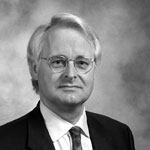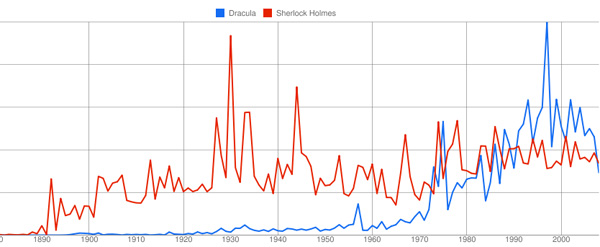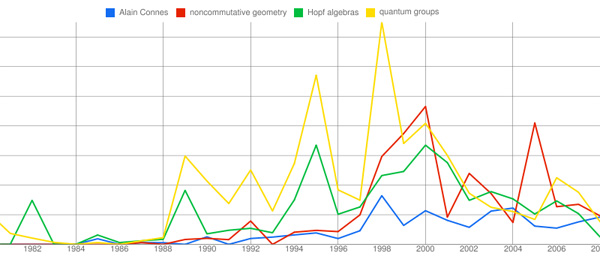Next time you visit your math-library, please have a look whether these books are still on the shelves : Michiel Hazewinkel‘s Formal groups and applications, William Fulton’s and Serge Lange’s Riemann-Roch algebra and Donald Knutson’s lambda-rings and the representation theory of the symmetric group.
I wouldn’t be surprised if one or more of these books are borrowed out, probably all of them to the same person. I’m afraid I’m that person in Antwerp…
Lately, there’s been a renewed interest in $\lambda $-rings and the endo-functor W assigning to a commutative algebra its ring of big Witt vectors, following Borger’s new proposal for a geometry over the absolute point.
 However, as Hendrik Lenstra writes in his 2002 course-notes on the subject Construction of the ring of Witt vectors : “The literature on the functor W is in a somewhat unsatisfactory state: nobody seems to have any interest in Witt vectors beyond applying them for a purpose, and they are often treated in appendices to papers devoting to something else; also, the construction usually depends on a set of implicit or unintelligible formulae. Apparently, anybody who wishes to understand Witt vectors needs to construct them personally. That is what is now happening to myself.”
However, as Hendrik Lenstra writes in his 2002 course-notes on the subject Construction of the ring of Witt vectors : “The literature on the functor W is in a somewhat unsatisfactory state: nobody seems to have any interest in Witt vectors beyond applying them for a purpose, and they are often treated in appendices to papers devoting to something else; also, the construction usually depends on a set of implicit or unintelligible formulae. Apparently, anybody who wishes to understand Witt vectors needs to construct them personally. That is what is now happening to myself.”
Before doing a series on Borger’s paper, we’d better run through Lenstra’s elegant construction in a couple of posts. Let A be a commutative ring and consider the multiplicative group of all ‘one-power series’ over it $\Lambda(A)=1+t A[[t]] $. Our aim is to define a commutative ring structure on $\Lambda(A) $ taking as its ADDITION the MULTIPLICATION of power series.
That is, if $u(t),v(t) \in \Lambda(A) $, then we define our addition $u(t) \oplus v(t) = u(t) \times v(t) $. This may be slightly confusing as the ZERO-element in $\Lambda(A),\oplus $ will then turn be the constant power series 1…
We are now going to define a multiplication $\otimes $ on $\Lambda(A) $ which is distributively with respect to $\oplus $ and turns $\Lambda(A) $ into a commutative ring with ONE-element the series $~(1-t)^{-1}=1+t+t^2+t^3+\ldots $.
We will do this inductively, so consider $\Lambda_n(A) $ the (classes of) one-power series truncated at term n, that is, the kernel of the natural augmentation map between the multiplicative group-units $~A[t]/(t^{n+1})^* \rightarrow A^* $.
Again, taking multiplication in $A[t]/(t^{n+1}) $ as a new addition rule $\oplus $, we see that $~(\Lambda_n(A),\oplus) $ is an Abelian group, whence a $\mathbb{Z} $-module.
For all elements $a \in A $ we have a scaling operator $\phi_a $ (sending $t \rightarrow at $) which is an A-ring endomorphism of $A[t]/(t^{n+1}) $, in particular multiplicative wrt. $\times $. But then, $\phi_a $ is an additive endomorphism of $~(\Lambda_n(A),\oplus) $, so is an element of the endomorphism-RING $End_{\mathbb{Z}}(\Lambda_n(A)) $. Because composition (being the multiplication in this endomorphism ring) of scaling operators is clearly commutative ($\phi_a \circ \phi_b = \phi_{ab} $) we can define a commutative RING $E $ being the subring of $End_{\mathbb{Z}}(\Lambda_n(A)) $ generated by the operators $\phi_a $.
The action turns $~(\Lambda_n(A),\oplus) $ into an E-module and we define an E-module morphism $E \rightarrow \Lambda_n(A) $ by $\phi_a \mapsto \phi_a((1-t)^{-1}) = (1-at)^{-a} $.
All of this looks pretty harmless, but the upshot is that we have now equipped the image of this E-module morphism, say $L_n(A) $ (which is the additive subgroup of $~(\Lambda_n(A),\oplus) $ generated by the elements $~(1-at)^{-1} $) with a commutative multiplication $\otimes $ induced by the rule $~(1-at)^{-1} \otimes (1-bt)^{-1} = (1-abt)^{-1} $.
Explicitly, $L_n(A) $ is the set of one-truncated polynomials $u(t) $ with coefficients in $A $ such that one can find elements $a_1,\ldots,a_k \in A $ such that $u(t) \equiv (1-a_1t)^{-1} \times \ldots \times (1-a_k)^{-1}~mod~t^{n+1} $. We multiply $u(t) $ with another such truncated one-polynomial $v(t) $ (taking elements $b_1,b_2,\ldots,b_l \in A $) via
$u(t) \otimes v(t) = ((1-a_1t)^{-1} \oplus \ldots \oplus (1-a_k)^{-1}) \otimes ((1-b_1t)^{-1} \oplus \ldots \oplus (1-b_l)^{-1}) $
and using distributivity and the multiplication rule this gives the element $\prod_{i,j} (1-a_ib_jt)^{-1}~mod~t^{n+1} \in L_n(A) $.
Being a ring-qutient of $E $ we have that $~(L_n(A),\oplus,\otimes) $ is a commutative ring, and, from the construction it is clear that $L_n $ behaves functorially.
For rings $A $ such that $L_n(A)=\Lambda_n(A) $ we are done, but in general $L_n(A) $ may be strictly smaller. The idea is to use functoriality and do the relevant calculations in a larger ring $A \subset B $ where we can multiply the two truncated one-polynomials and observe that the resulting truncated polynomial still has all its coefficients in $A $.
Here’s how we would do this over $\mathbb{Z} $ : take two irreducible one-polynomials u(t) and v(t) of degrees r resp. s smaller or equal to n. Then over the complex numbers we have
$u(t)=(1-\alpha_1t) \ldots (1-\alpha_rt) $ and $v(t)=(1-\beta_1) \ldots (1-\beta_st) $. Then, over the field $K=\mathbb{Q}(\alpha_1,\ldots,\alpha_r,\beta_1,\ldots,\beta_s) $ we have that $u(t),v(t) \in L_n(K) $ and hence we can compute their product $u(t) \otimes v(t) $ as before to be $\prod_{i,j}(1-\alpha_i\beta_jt)^{-1}~mod~t^{n+1} $. But then, all coefficients of this truncated K-polynomial are invariant under all permutations of the roots $\alpha_i $ and the roots $\beta_j $ and so is invariant under all elements of the Galois group. But then, these coefficients are algebraic numbers in $\mathbb{Q} $ whence integers. That is, $u(t) \otimes v(t) \in \Lambda_n(\mathbb{Z}) $. It should already be clear from this that the rings $\Lambda_n(\mathbb{Z}) $ contain a lot of arithmetic information!
For a general commutative ring $A $ we will copy this argument by considering a free overring $A^{(\infty)} $ (with 1 as one of the base elements) by formally adjoining roots. At level 1, consider $M_0 $ to be the set of all non-constant one-polynomials over $A $ and consider the ring
$A^{(1)} = \bigotimes_{f \in M_0} A[X]/(f) = A[X_f, f \in M_0]/(f(X_f) , f \in M_0) $
The idea being that every one-polynomial $f \in M_0 $ now has one root, namely $\alpha_f = \overline{X_f} $ in $A^{(1)} $. Further, $A^{(1)} $ is a free A-module with basis elements all $\alpha_f^i $ with $0 \leq i < deg(f) $.
Good! We now have at least one root, but we can continue this process. At level 2, $M_1 $ will be the set of all non-constant one-polynomials over $A^{(1)} $ and we use them to construct the free overring $A^{(2)} $ (which now has the property that every $f \in M_0 $ has at least two roots in $A^{(2)} $). And, again, we repeat this process and obtain in succession the rings $A^{(3)},A^{(4)},\ldots $. Finally, we define $A^{(\infty)} = \underset{\rightarrow}{lim}~A^{(i)} $ having the property that every one-polynomial over A splits entirely in linear factors over $A^{(\infty)} $.
But then, for all $u(t),v(t) \in \Lambda_n(A) $ we can compute $u(t) \otimes v(t) \in \Lambda_n(A^{(\infty)}) $. Remains to show that the resulting truncated one-polynomial has all its entries in A. The ring $A^{(\infty)} \otimes_A A^{(\infty)} $ contains two copies of $A^{(\infty)} $ namely $A^{(\infty)} \otimes 1 $ and $1 \otimes A^{(\infty)} $ and the intersection of these two rings in exactly $A $ (here we use the freeness property and the additional fact that 1 is one of the base elements). But then, by functoriality of $L_n $, the element
$u(t) \otimes v(t) \in L_n(A^{(\infty)} \otimes_A A^{(\infty)}) $ lies in the intersection $\Lambda_n(A^{(\infty)} \otimes 1) \cap \Lambda_n(1 \otimes A^{(\infty)})=\Lambda_n(A) $. Done!
Hence, we have endo-functors $\Lambda_n $ in the category of all commutative rings, for every number n. Reviewing the construction of $L_n $ one observes that there are natural transformations $L_{n+1} \rightarrow L_n $ and therefore also natural transformations $\Lambda_{n+1} \rightarrow \Lambda_n $. Taking the inverse limits $\Lambda(A) = \underset{\leftarrow}{lim} \Lambda_n(A) $ we therefore have the ‘one-power series’ endo-functor
$\Lambda~:~\mathbf{comm} \rightarrow \mathbf{comm} $
which is ‘almost’ the functor W of big Witt vectors. Next time we’ll take you through the identification using ‘ghost variables’ and how the functor $\Lambda $ can be used to define the category of $\lambda $-rings.


 However, as
However, as